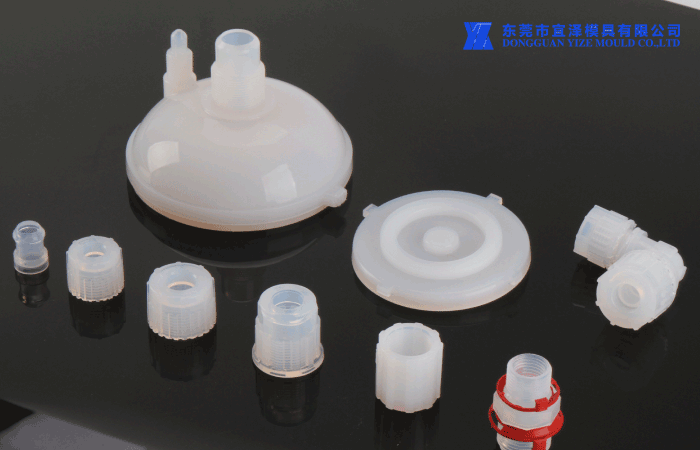What is the difference between soluble polytetrafluoroethylene (PFA) and polytetrafluoroethylene (PTFE) for teflon plastic injection mold factory?
Soluble polytetrafluoroethylene (PFA) is soluble polytetrafluoroethylene. The material is sintered at high temperature and has fluidity. Teflon plastic injection mold factory is mainly used for injection molding chemical parts, and the operating temperature is generally within 220.
Polytetrafluoroethylene (PTFE) material is sintered at high temperature and has no fluidity. It is not produced by OEM teflon plastic injection mold process. It is generally produced by molding or pushing. It is mainly used for chemical or mechanical parts. The operating temperature is -180+260 The temperature of modified PTFE can be close to 280 degrees.
The first is the difference in chemical structure:
PFA has added a perfluoroalkoxy group, which is equivalent to the replacement of a fluorine atom in PTFE by a perfluoroalkoxy group. A carbon is directly attached to an oxygen, and then the oxygen is attached to a group such as perfluoromethyl or perfluoroethyl. Compared with PTFE, the reduced melt viscosity facilitates processing. The rest of the properties are not much worse than PTFE.

The second is the difference in application for teflon plastic injection mold factory: PFA--has the same various excellent properties as polytetrafluoroethylene, and has good thermoplasticity, and can be processed by ordinary thermoplastic resin processing methods. It is prepared by copolymerization of tetrafluoroethylene and perfluoropropyl vinyl ether in a certain proportion in an aqueous medium containing a perfluorocarboxylate dispersant and a persulfate initiator. It appears as white and translucent particles.
Not only has the same service temperature as PTFE, but also has better mechanical strength (about 2 to 3 times) at 250 ° C, and has excellent stress crack resistance. It has a wide processing range and good molding performance, and is suitable for molding processes such as compression molding, extrusion molding, injection molding, and transfer molding. Corrosion-resistant linings for wire and cable insulation sheaths, high-frequency and ultra-high-frequency insulation parts, chemical pipelines, valves and pumps; special parts for machinery industry, various anti-corrosion materials for light and textile industries, and polytetrafluoroethylene anti-corrosion linings Wait for the welding rod.
Extruded from meltable polytetrafluoroethylene pellets, the appearance is translucent and milky white, the surface is smooth, and the cross-section is dense and uniform. It is specially used for the welding of PTFE plates and tubes, so that PTFE products with simple shapes can be welded into parts with complex shapes and large sizes.
The aqueous dispersion is obtained by adding an emulsifier to the copolymer obtained by the copolymerization reaction of tetrafluoroethylene and perfluoropropyl vinyl ether, and concentrating at a certain temperature. The solid content is 30%±1%. The appearance is milky white or light yellow translucent. It has various excellent properties of meltable polytetrafluoroethylene resin. It can be used for a long time at 260°C, and has been developed into an advanced coating with its excellent anti-sticking, anti-corrosion and easy-processing properties. It can be sprayed and dipped. It is widely used in copying technology and food industry as anti-sticking and anti-corrosion materials.
PTFE-polytetrafluoroethylene is made by polymerization of tetrafluoroethylene monomer by suspension method or dispersion method. Molecular weight = 5.2×105-4.5×107. White powder, 75% of 400 mesh, tasteless, non-beautiful, non-toxic. The relative density is 2.1-2.3, the refractive index is 1.37, the glass transition temperature is 327°C, and the thermal decomposition temperature is 415°C. When it is above 400 ℃, there is a slight weight loss and toxic gas is decomposed.
The service temperature is -250~260 ℃, and it can be used for 10000 hours at 210 ℃. Excellent chemical corrosion resistance, resistant to any strong acid (including aqua regia), strong alkali, grease, insoluble in any solvent, extremely low friction coefficient, good wear resistance, and self-lubricating. Excellent aging resistance. Excellent electrical properties, good arc resistance. It is non-sticky, almost all sticky substances cannot adhere to its surface, and it is completely non-flammable. Known as the "King of Plastics". Tensile strength (MPa)>23 elongation (%)>250.
Again, the difference in processing methods: The main difference in processing methods is that PFA can be processed by hot-melt injection molding, while PTFE cannot be processed by hot-melt injection molding.